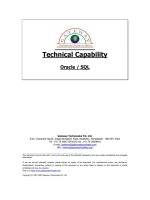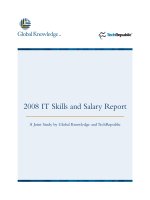Tài liệu 2008_Salary Report docx
Bạn đang xem bản rút gọn của tài liệu. Xem và tải ngay bản đầy đủ của tài liệu tại đây (508.22 KB, 12 trang )
2008 IT Skills and Salary Report
–––––––––––––––––––––––––
A Joint Study by Global Knowledge and TechRepublic
T
he IT profession has experienced dramatic changes
within the past 10 years and the pace is not slowing.
J
ust within the past year, we have seen:
• Vista, a new OS from Microsoft
• Leopard, a new OS from Apple
• A new certification program from Cisco
• A new certification program from Microsoft
• A record year for data security breaches
• An increase in the importance of balancing IT
and business skills
While the industry continues to grow and evolve,
the attitudes, behaviors, and concerns of IT profes-
sionals have not changed much from last year’s sur-
vey. In fact, the results are comparable with the
2007 data as well as with similar surveys conducted
by other groups.
Key Report Findings
• Modest overall salary growth
This year’s average was up 3.25% from our 2007
findings to $73,963. The number of participants
that reported receiving a raise was also up from
68.7% to 80%. However, the average salary
increase this year was 4.0% compared to almost
5% last year.
• Education and training impact salary
The average salary for those with a four-year
degree is $76,446 compared to $65,712 for a
certificate or degree from a technical school.
While four-year and graduate degrees offer a
more diverse education, additional training and
certification also have an impact on salary.
• Why people take training
An overwhelming majority of 65% indicated that
their major motivation for training was to build new
skills and knowledge. An additional 9% cited the
desire to refresh existing skills and knowledge.
•
Multi-tasking and breadth of experience
Rare are professionals who concentrate exclu-
sively on mainframe or vendor
-specific work. It is
not uncommon for a network administrator to
multi-task, linking Microsoft V
ista through Cisco
routers against a Linux-based server. As well,
we’ve seen an increase in the popularity of busi-
ness skills, including project management.
•
Confidence in the IT job market
While employment growth and salaries have
r
isen, an uncertainty in the U.S. subprime market
is viewed as a catalyst for caution by some indus-
tries. The rapid collapse of IT in 2001, coupled
with the speed of change, caused veterans to be
mindful and newcomers to consider career paths
perceived as less risky.
• Outsourcing/off-shoring of jobs
IDC reports an increase of 20% annually world-
wide, of which the U.S. represents more than
$730 million. There appears to be a consensus
that the rise in complexity of the technology and
the demand for 24/7 customer response will con-
tinue to fuel the need for continued outsourcing
of some operations.
Participant Profile
To reach a wider and more diverse group of IT
professionals, this year’s survey was conducted
jointly by Global Knowledge and TechRepublic.
This collaborative effort yielded a total of 7,193
responses. (See page 12 for survey methodology.)
The age and experience of survey participants con-
tinues to increase. Nearly half of all of the respon-
dents are age 46 or older
. As illustrated in
Figure 1,
the average age is 43 and the average time of expe-
rience is nearly 15 years. However
, the labor pool contin
-
ues to shrink at the same time that demand for skilled
professionals grows. The Bureau of Labor Statistics (BLS)
projects that the labor force for the 25-54 age group
will increase at an annual rate of only 0.2% between
2006 and 2016.
2008 IT Salary and Skills Report
Copyright ©2008 Global Knowledge T
raining LLC. All rights reserved.
Page2
Base Salary
$73,963
Received a Raise
80.0%
Raise/Increase Amount
4.0%
Received a Bonus
48.7%
Age
43.0
Years in IT
14.3
Male vs. Female
3:1
Education
59% have at least a 4-year degree
Profile of Respondents
Figure 1
Copyright ©2008 Global Knowledge Network, Inc. All rights reserved.
Page 3
Job Satisfaction
Job stability and a desire for a higher base compensation
topped the list of job satisfaction factors, followed close-
l
y by a challenging job role and family issues, including
health care benefits. Our survey respondents indicated
t
hat stock options and profit sharing are the least impor-
tant factors in rating job satisfaction (see
Figure 2).
We asked several sets of questions about job satisfaction
to glean an understanding of what IT professionals are
looking for in their work environments. We’ve learned
t
hat most are pleased with their current base salary, but
not with their last raise or most recent bonus (see
Figures
3
, 4, and 5
)
. However, the workload and environment
were rated better than average by most respondents.
Of our survey respondents, 78.7% stated
that they were “very” or “mostly” satisfied
with their career choice.
10% 20% 30% 40% 50% 60%
Less Stress
1
6.7%
2
.2%
Stock Options
Profit Sharing
4.5%
6.3%
E
ntrepreneurial
E
nvironment
Reptutation of
C
ompany
7.2%
1
0.5%
More Flex Time
Telecommuting Options
1
0.6%
1
6.9%
High/New Technology
Environment
Training/Education
Support
18.5%
2
0.7%
Location
Consideration of
Personal/Family Needs
31.6%
32.9%
Challenging Job Role
Higher Base
Compensation
44.9%
47.1%
Job Stability
Health Care Benefits
29.4%
Figure 2 – Top Job Satisfaction Factors
Figure 3 – Base Salary Satisfaction
Figure 4 – Satisfaction with Last Raise
Figure 5 – Satisfaction with Work Environment
I
n addition to their base salary, 49% of respondents
received a bonus (see
Figures 6 and 7).This is slightly
down from last year’s survey, where 52% received a
bonus. The average bonus amount remained consis-
t
ent. The average for last year was $3,963, while this
year was $3,937.
While the prospect of a high base salary is appealing
to everyone, compensation can come in many forms.
In addition to bonuses, 79.81% reported that their
employer offers a 401k or other retirement program,
68.97% received life insurance, 83.61% received
medical/dental insurance, and 90.16% received vaca-
tion, personal, or sick leave.
What Concerns Are on the Minds of IT Professionals?
To get some ideas to keep and promote IT staff, we
asked questions about what is important to them in
considering a new job or staying with their current
employer. While concerns about the economy were
evident, the number one concern was still keeping
up with skills (see Figure 8).
Copyright ©2008 Global Knowledge Network, Inc. All rights reserved.
Page 4
Figure 6 – Bonus Satisfaction
Figure 7 – Bonus Received Within the Past 12 Months
10% 20% 30% 40% 50% 60%
Reduction of Benefits
36.15%
2
2.86%
R
educed Demand
f
or Company
P
roducts/Services
Outsourcing
26.58%
28.03%
Current Seniority and
Pay Competing Against
New Hire
Hiring Freeze
28.88%
30.93%
Downsizing
Salary Freeze
32.03%
44.5%
Recession Affecting
Economy
Limited Budget to
Meet Expectations
46.46%
56.75%
Keeping Up With Skills
Figure 8 – Concerns of IT Professionals
Top 10 Tech Skills You Should Develop
If you like to be constantly developing new
skills, IT is the right field for you. In the late
80s, NetWare and IPX/SPX administration
were the skills to have. Today, it’s all about
TCP/IP and the Internet. Here are 10 skills
you should develop to keep on top of things
in the tech world in the next five years.
1. Voice over IP
2. Unified communications
3. Hybrid networks
4. Wireless technology
5. Remote user support
6. Mobile user support
7. Software as a service
8. Virtualization
9.
IPv6
10. Security
Read more and comment
here.
W
ho Is Making the Money?
Salary is driven by a number of factors, several of
which are correlated or change in importance over
time. We analyzed the data by looking at education,
e
xperience, certification, training, job level, region,
and other key demographics. By a far margin, expe-
r
ience within the field is the single most important
factor in determining salary. Even among those in
the same age group, education level, and job level,
experience tops out.
Overall, salaries showed a modest increase when
compared to last year’s survey. In 2007, the average
reported salary was $71,556. This year’s average
was up 3.25% to $73,963 (see
Figure 9). The num-
ber of participants that reported receiving a raise
was also up from 68.7% to 80%. While more peo
-
ple did get a slice of the pie, the piece they
received was smaller. The average raise/increase
amount this year was 4.0% compared to almost 5%
last year (see
Figure 10).
For the most part, one can choose where to live and
work, pursue education, change jobs, or take other
action to improve salary. However, external factors
substantially change the equation. Recessions, merg-
ers, recalls, and rapidly changing technology are but
a few that have impacted the IT professional.
Consistent with most reports, 80% of the respondents
received a raise in the past year with an average
increase of 4.0%, doing a little better than inflation.
The majority, 39%, received a standard raise from
Copyright ©2008 Global Knowledge Network, Inc. All rights reserved.
Page 5
2%
7.4%
< $
35k
4%
6%
8
%
1
0%
12%
1
4%
1
6%
$35k -
$4
5k
9
.9%
12.6%
$45k -
$5
5k
$55
k -
$65k
12.8%
13.6%
$65 -
$7
5k
$75 -
$8
5k
12%
$85 -
$9
5k
9
.7%
8%
$95
k - $1
05k
$105k
- $1
15k
5
.1%
3.2%
$11
5k
- $125k
$125k
- $1
35k
2.1%
1%
$135k
- $1
45k
>$1
45k
2
.6%
Figure 9 – Salary of All Respondents by Range
Nearly half of those responding earn a
salary between $45,000 and $85,000 per
year in nearly equal groups.
10% 20% 30% 40% 50%
– 10% or More
1.21%
12.69%
+ 10% or More
+ 5% - 9%
23.10%
45.02%
+ 1% - 4%
No Change
16.5%
0.70%
– 1% - 4%
– 5% - 9%
0.78%
Figure 10 – Change in Base Salary in the Past 12 Months









